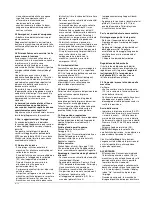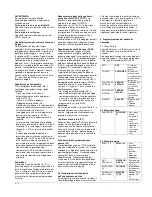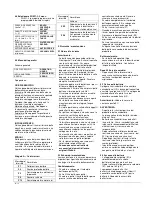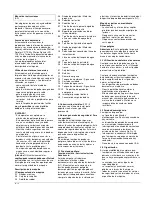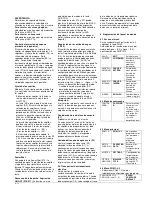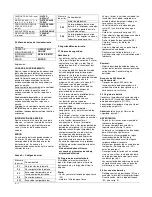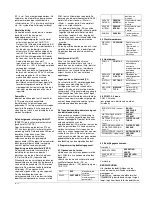
31 / 74
2.6 Before the machine is put into
operation / Initial operation
Delivery; instruction in safety rules,
operation and maintenance; and initial
operation are normally performed by a
Wetrok-authorized technician. If this is not
the case, then the operator is responsible
for instructing those who work with the
machine.
A new battery does not deliver full power
until after approx. 5 – 10 charge and
discharge cycles. A significantly shortened
operating time per charging indicates that
the batteries are exhausted and must be
replaced.
Risk-free work with the unit is possible only
if you read the operating instructions and
safety information in their entirety and
strictly follow the instructions contained in
them.
Safety instructions for operating and
maintaining the machine are presented
in the relevant sections of this manual
and must be followed unconditionally.
Also observe the safety tips contained in
the pictograms on the machine.
3. Operation / Use tips
Depending on the model and equipment,
the design of your unit may differ in matters
of detail form the standard design as
described.
The brush housing for the XR70 can be
exchanged easily with the XR90 brush
housing. The Wetrok service department
will be happy to advise you.
3.1 Safety instructions
-
Inspect the machine before each use.
Allow only qualified professionals to repair
damage.
-
The tank housing (E1) and tank cover
must be closed and locked before use.
-
Use caution when working near other
persons, especially children.
-
To avoid injury, wear solid footwear.
-
Before cleaning and maintaining the
machine, replacing or dismantling working
parts, drive the machine onto a flat, level
surface and remove the key from the
main switch.
-
Only original Wetrok working parts may
be used.
-
The machine may be used only on slopes
or gradients no greater than 8%. Use
extreme caution and travel slowly when
making turns on rising or falling slopes.
When moving over ramps, the direction of
travel must be perpendicular to the
gradient.
-
The machine must be secured against
unintentional movement when left on a
slope or lift. Remove the key from the
main switch.
-
The cable connection between batteries
and the machine must be removed before
any work is performed on electrical
components. (Emergency stop connector:
G1/H1)
3.2 Use restrictions
The machine must not be used in
temperatures below 1° C or above 45° C.
The water temperature must not exceed
50° C.
Foaming or corrosive cleaning agents or
combustible solvents must never be used.
Use only water and machine-compatible
cleaning agents.
3.3 Preparatory work
Begin by removing large particles and
paper from the surface to be cleaned.
Note: The machine can pick up coarse
particles such as gravel or wood splinters.
Make sure, however, that sensitive
surfaces are swept or damp wiped in
advance, as scratch marks may otherwise
occur.
3.4 Setting up
The choice of cleaning agents and working
parts depends on the type of floor and the
degree of soiling. Always observe the
correct dosage.
Thorough cleaning or heavy soiling
Wetrok Remat or Antiwax/Exal.
Dilution 1:20.
Smooth floors: pad drive disc with Wetrok
polypad (black or green)
Rough floors (e.g., natural stone):
scrubbing brush
Regular cleaning:
Wetrok Redur or Resal. Dilution 1:100.
Pad drive disc and green or red polypad, in
some circumstances a scrubbing brush
Dismantling / installing working parts:
-
Only original Wetrok working parts may
be used.
-
To release the brushes, press button
(P16) on the operating panel. An
animated graphic will appear on the
display.
-
Remove old working parts.
-
Pre-position new working parts by hand
on the floor under the brush housing (A2).
If using pads, attach them beforehand to
the pad drive discs.
-
Couple brushes or pad drive discs with
pads. Press button (P17) on the operating
panel. An animated graphic will appear on
the display.
Use caution with sensitive floor
coverings.
Filling with fresh water / cleaning
agents:
-
Lift up the tank cover.
-
Fill the fresh water tank (F5) with water.
-
Add the desired cleaning agent in the
prescribed dosage. Always observe the
correct dilution! The tank’s diaphragm is
provided with markings as a guide.
-
Close the tank cover.
Setting up the suction nozzle
The ideal result depends on the suction lips
used, the application pressure and the
setting. Set the
tilt angle (B1) and the
height adjustment
(B3)
to achieve the
optimal suction effect.
3.5 Operation / Initial operation of the
machine
Check:
-
The emergency stop connector (G1) must
be plugged in and functioning (with the
battery charger cable removed).
-
Check the driver’s seat position. After
adjusting the seat, make sure that the
seat’s locking device is engaged
Driving
-
Enter the direction of travel (P6/P7):
LED for forwards illuminated = forward
travel
LED for backwards illuminated = reverse
travel
-
Select maximum or reduced speed.
Press button P14 or P15 on the operating
panel.
-
Actuate the accelerator pedal (A5).
CAUTION:
Adjust the speed to the nature
or condition of the floor, the environment
and the level of soiling (see
Traction
control
).
All functions are started by pressing the
Go/Stop
button (brushing, water feeding
and suction).
NOTE:
-
When the machine is switched on with the
main key switch (G2), it goes
automatically into the “zero” position
before new commands can be entered
(the brush lift and nozzle motors are in
their highest limit positions, and all motors
are turned off). When “Go” appears on
the display, the machine is ready for use.
-
When the machine is switched off, it
requires a short period of time to
completely switch off the controls. It is
best to wait a few seconds before
switching the machine back on.
-
When left idle, the machine will turn itself
off after a while by means of the “power
down” function in order to protect the
battery.
-
Pull the emergency stop connector if the
machine will not be in use for an
extended period.
-
If the battery discharge indicator (P1) is
not on “half full” or “full” when the
machine is turned on, the batteries must
be charged before the machine is used
(see the
Battery discharge monitor
section).
-
The brush housing (A2) is lowered by
pressing the “Go” button. Water feeding,
brush rotation and suction will begin
automatically (see also the
Adjusting the
brushes
section).
-
When the machine is standing still, the
brush housing (A2) will descend only as
far as the stand-by position (1 second
before contact with the floor). It will
descend further into the working position
only when the machine begins to travel



